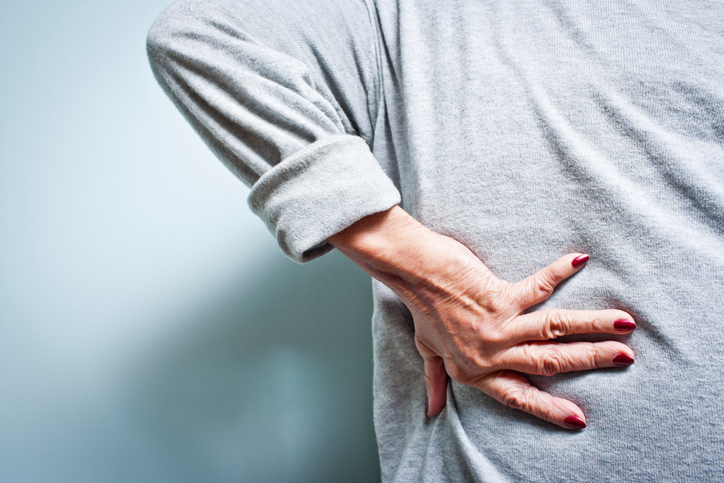For Your Safety - Screening, masks, and sanitation will continue to be implemented at our facility. Please see our blog post for more information.
When Is Your Back Pain Chronic?
Pain is a reaction of our nervous system. As uncomfortable as it is, sudden pain is a form of survival our bodies have developed to warn us of possible injuries or damage.
It should decrease as the injury heals. However, in chronic pain, the pain signal is being sent to the brain even if the injury is totally healed. That’s why it can be very disabling, even challenging the daily life.
Pain is considered chronic if it lasts more than 12 weeks/3 months. It can be continuous or intermittent, sharp, dull, burning, aching, or come and go without reason. In the following article, you’ll find more in-depth information about the topic.
What Is Chronic Back Pain, Exactly?
Pain is often classified by duration. Each period of time helps to diagnose the root cause of the pain, the best treatment, the outcomes, etc. The classification is as follows:
Acute Back Pain
Acute pain is vital for the body, as it warns the brain for injuries or potential harms. It’s present between the first day up to 4-6 weeks of the pain episode. It usually has an identifiable cause and it’s related to direct damage of the tissue. Common causes include traumatic events (such as a muscle strain due to a sudden movement, a direct hit, a sports injury), surgery, and labor, for example. An episode of back pain is acute if:
- It appears for the first time in a patient’s life.
- It appears after a pain-free period of at least six months, where the pain episode lasts no longer than 6 weeks. If there’s a complete recovery between acute episodes, the back pain is considered “acute recurrent”.
In an acute phase of back pain without a preceding traumatic event or an identified cause (e.g. weight-lifting, falling, sports injury…), is imperative to be properly assessed by a healthcare professional to diagnose the root cause.
Other reasons for immediate medical evaluation are:
- An injury related to a fall from a height or a motor vehicle crash.
- Minor fall or heavy lifting in a patient with/suspected of osteoporosis.
- Major weakness, numbness, tingling, loss of bladder/bowel control, or any sensory deficit related to the acute pain episode.
- Possible infection.
- History of cancer.
Subacute Back Pain
This phase follows the acute and precedes the chronic. It’s roughly between 2-3 months since the episode of back pain.
When pain persists or is not treated properly, the risk of developing chronic pain increases. This can happen due to a mixture of reasons, such as lack of exercise, malnutrition, how does the person feel about the pain, and emotional states (depression and anxiety).
Chronic Back Pain
Pain is considered chronic if it lasts more than 3 months. It usually has related characteristics, such as:
- It tends to remain even after the healing process is finished.
- It can disrupt sleep.
- It can be disabling.
- It may not have an apparent cause.
- Environmental and emotional factors aggravate or perpetuate the pain.
Examples of conditions or diseases with chronic back pain include:
- Herniated disk.
- Spinal stenosis.
- Chronic fatigue syndrome.
- Osteoarthritis.
- Myofascial pain.
- Fibromyalgia.
- Postsurgical pain.
- Post-traumatic pain.
There’s a type of chronic pain, neuropathic pain, where the pain is caused by an abnormal processing of nerve signals. This means that the pain is unrelated to an injury or condition, i.e. the nerves send pain signals to the brain even though there isn’t an injury present.
This type of pain is usually severe, sharp, stabbing, burning, and/or cold. There can be presence of numbness, tingling, weakness, and the pain can follow a specific path, e.g. from the neck, down the shoulder, all the way down to the hand. If the medical treatment is delayed, it will be harder to manage.
Low levels of physical activity and depression are strong predictors of chronic back pain, increasing the risk up to 14%-17% of suffering from it over the following decade.
The most common place for developing chronic pain in the back is:
- The lower-back/lumbar spine. That area has a tendency to be unstable and it must support the weight of the trunk and the upper body. This combination makes it prone to develop injuries and pain. It’s followed by:
- The upper-back/cervical spine. This area can develop chronic pain due to bad ergonomics, i.e. having rounded shoulders in front of the computer. This increases the tension on the upper back and causes pain.
How To Identify Chronic Pain
The course of chronic back pain can vary depending on factors such as stress levels, sedentarism, smoking, age, or lifestyle, just to name a few. However, the most important factor to evaluate if the pain is chronic or not, is the permanence of pain continuously for +3 months, or +12 weeks. It can be cyclical in some cases, with acute exacerbations overlapping the chronic pain.
Risk factors for chronic back pain are:
- History of previous injury/surgery.
- Older age.
- Overweight/Obesity.
- Smoking.
- Lack of exercise.
- Malnutrition.
- Female sex.
- Keeping the same position for long periods of time, such as sitting in front of the computer or standing.
- Certain positions, such as lying on the back, can be aggravators.
- In certain disk disorders, forward flexion aggravates the pain. In other spinal diseases, back extension aggravates the pain.
- Stressful environment, depression or anxiety.
Activities That Contribute To Chronic Back Pain
Conclusion
Chronic back pain is a very common condition that can be easily prevented by:
- Doing any kind of exercise. It’s recommended to do at least 150 minutes of moderate-intensity activities per week (walking, bicycling).
- Eating healthily. Include vegetables and fruits on your plates, avoid processed foods.
- Reducing the stress levels. Meditation and breathing exercises are good tools for stress management.
- Having ergonomic habits, such as:
- Changing positions every 1-2 hours in your workplace. You can stand up from your desk every 2 hours, walk, take a glass of water, and go back to work in 15 minutes.
- Keep the screen at eye-level.
- Keep your knees and elbows at 90º of flexion.
- Keep your feet steady on the floor, and your arms resting on the armrests.
Sources
- Delitto, A., George, S. Z., Van Dillen, L., Whitman, J. M., Sowa, G. A., Shekelle, P., … Godges, J. J. (2012). Low Back Pain: Clinical Practice Guidelines Linked to the International Classification of Functioning, Disability, and Health from the Orthopaedic Section of the American Physical Therapy Association. The Journal of Orthopaedic and Sports Physical Therapy, 42(4), A1–57. http://doi.org/10.2519/jospt.2012.42.4.A1
- Adult Acute and Subacute Low Back Pain. Institute For Clinical Systems Improvement. Fifteen Edition, Jan 2012. [PDF] Available at: https://www.healthpartners.com/ucm/groups/public/@hp/@public/documents/documents/cntrb_035022.pdf
- Casazza, B. Diagnosis and Treatment of Acute Low Back Pain. American Family Physician, 85 (4), February 15, 2012. 343-350. Available at: https://www.aafp.org/afp/2012/0215/p343.pdf
- Pain: Current Understanding of Assessment, Management, And Treatments. National Pharmaceutical Council. [PDF] Available at: http://americanpainsociety.org/uploads/education/npc.pdf
- Brady, S. R. E., Hussain, S. M., Brown, W. J., Heritier, S., Billah, B., Wang, Y., … Cicuttini, F. M. (2016). Relationships Between Weight, Physical Activity, and Back Pain in Young Adult Women. Medicine, 95(19), e3368. http://doi.org/10.1097/MD.0000000000003368
- Casser, H.-R., Seddigh, S., & Rauschmann, M. (2016). Acute Lumbar Back Pain: Investigation, Differential Diagnosis, and Treatment. Deutsches Ärzteblatt International, 113(13), 223–234. http://doi.org/10.3238/arztebl.2016.0223
- Chanda, M. L., Alvin, M. D., Schnitzer, T. J., & Apkarian, A. V. (2011). Pain characteristic differences between subacute and chronic back pain. The Journal of Pain: Official Journal of the American Pain Society, 12(7), 792–800. http://doi.org/10.1016/j.jpain.2011.01.008

